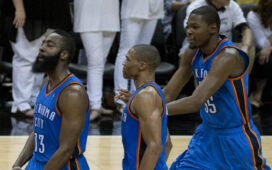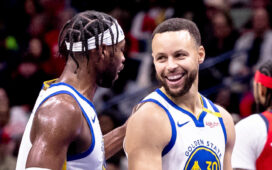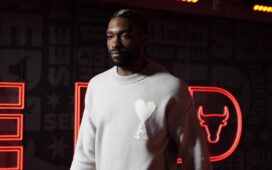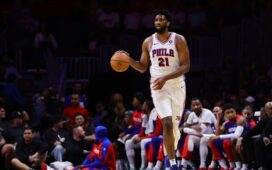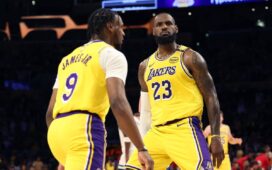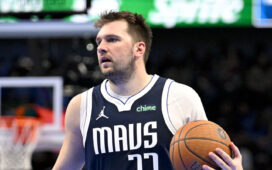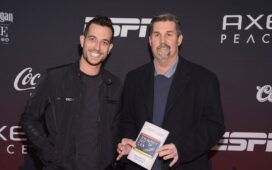Due to pandemic delays, the Basketball Hall of Fame will be inducting two classes in 2021. And though it’s quite a group this year — the Hall welcomes Tim Duncan, Kevin Garnett, Kobe Bryant, and Tamika Catchings, among others — there’s a huge class of worthy players still sitting outside the gates of the Hall. And it’s about time for players like Ben Wallace, who have to wait in line behind the likes of Dino Radja and whatever moderately successful college coach makes it, to get in. The Hall of Fame is for the best of the best, to be sure, but it also needs to include the significant players, the forgotten achievements, and above all, more guys who dunk the living hell out of the ball. So here’s our list of the 25 best NBA players that the Hall of Fame has yet to recognize.
1 of 24
Paul Piere and Chris Bosh

Photo by Christopher Polk/Getty Images for Verizon
We’re combining these two players because they’re basically shoo-ins for induction in 2021. Chris Bosh made eleven All-Star teams while Paul Pierce made ten. Bosh was on two Miami Heat NBA champions in 2012 & 2013, and went to the Finals four straight years, while Pierce won Finals MVP when his Celtics won in 2008. Bosh would have even more accolades had a blood clot problem shortened his career, although Pierce is the one most likely to be pushed into the Hall sitting in a wheelchair.

Jed Jacobsohn / Getty Images
C-Webb was one of the greatest power forwards of his era and maybe the best passing power forward of all time. He was the best player on two of the most beloved basketball teams of all time: the early-2000s Sacramento Kings and the Fab Five Michigan Wolverines. Not only was he a great player, but he made beats for Nas, dated Tyra Banks and was one of the best actors in “Uncle Drew,” behind Tiffany Haddish and slightly ahead of Shaq.

(Photo by Rocky Widner/NBAE via Getty Images)
After making three straight All-Star teams with the “Run TMC” Warriors, Tim Hardaway blew out his knee and missed a whole season, yet he somehow came back an even better player. He was fourth in the MVP voting when he was with Miami in 1997 and shot 44 percent from three and made the Conference Finals. Hardaway made awful homophobic comments in 2007, but to his credit, he began working with LGBT organizations and by 2013, he was the first signer on a petition to legalize gay marriage in Florida.

Photo by Rocky Widner/NBAE via Getty Images
People say defense wins championships, but we disagree: Robert Horry wins championships. Horry won two titles with the Houston Rockets, three more with the Lakers and then two more with the Spurs. It wasn’t luck either. “Big Shot Rob” was incredible in big games. In Game 1 of the 1995 Finals, Horry blocked five shots and hit four threes, he had seven steals in Game 2 and hit a game-clinching three-pointer in Game 3. He saved the Lakers in the 2002 Conference Finals with a miracle buzzer-beater in Game 4. In Game 5 of the 2005 Finals, Horry came off the bench to score 21 points, including five three-pointers, a huge dunk over Rip Hamilton and the game-winning shot in overtime. If Hall of Fame voters wait until the last second to vote, Horry has an excellent chance of going in.

Photo by Scott Cunningham/NBAE/GettyImages
Lou Hudson made six straight All-Star games, from 1970-75, and in his 11 years on the Hawks, he averaged 26.4 points per game. His career totals would be even higher had he not spent a year in the military early in his career. He’s also the first NBA player to get the nickname “Sweet Lou,” because of his sweet jumper, which was dramatically better than “Sweet Lou” Piniella’s outside shot.

DAN LEVINE/AFP/Getty Images
Rasheed Wallace might be the coolest player in NBA history. Aside from being an elite player, he deserves recognition for popularizing the phrases “ball don’t lie,” “cut the check,” and “both teams played hard,” as well as his amazing caroling. He was an NBA champion in 2004, after which he paid for championship belts to be made for his teammates, and he was one close Game 7 away in 2000, 2005 and 2010. One of the smartest and best defensive players in the league, he didn’t get a ton of accolades, mainly because he didn’t care (though he made four All-Star teams). He’s also third all time in technical fouls, behind Hall of Famers Charles Barkley and Karl Malone. In fact, if you enter “technical fouls” into the Basketball Reference search box, it sends you to Rasheed Wallace’s page.

Getty Images
For the five years of his short NBA career, Bob Feerick was an excellent player, making first team All-NBA in both 1947 and 1948. So good, in fact, that he was a finalist for the NBA’s 25th Anniversary Team. Feerick also worked as a coach, general manager, and director of player personnel after his playing career, so he made plenty of contributions to the game. He shouldn’t be penalized just because there wasn’t a pro basketball league until he was 26 years old.

Photo by Allen Einstein NBAE/Getty Images
Some people argue that Ben Wallace isn’t a Hall of Famer because of his short peak. But that “short peak” included four straight Defensive Player of the Year awards, four All-Star appearances, five all-NBA teams and a title. Big Ben was listed at 6-foot-9 but was more like 6-foot-6, though that didn’t stop him from leading the league in blocks and rebounds. His attitude and hairstyle intimidated opposing players out of the paint for a decade and honestly, the Hall hasn’t inducted him yet because it’s afraid.

Photo by Vernon Biever/NBAE via Getty Images
Larry Costello was a point guard in the earliest days of the NBA, and he made six All-Star teams for the Philadelphia Warriors and Syracuse Nationals. He came out of retirement to play for the 68-win, NBA champion 76ers in 1967, and as the first-ever coach of the Milwaukee Bucks, he led them to a title in 1971. Costello may have been the last two-handed set shooter to play in the NBA, so let’s just say he might have trouble with modern NBA defenses. While attending Niagara University, he played 69 minutes in a six-OT game against Siena, and the school changed his number to 69 as a result. Nice.

Photo by Charles T. Higgins/NBAE via Getty Images
Larry Foust (far left in the photo) made the All-Star team eight times, the most of any non-Hall of Famer. He was drafted by the Chicago Stags, who you may not remember because they folded before Foust played a single game for them. He was the fifth pick in the draft, which would be like the Orlando Magic folding before Mo Bamba could play for them. Foust, nicknamed “Desert Head” by Hot Rod Hundley due to his baldness, may have been dismissed because he played in the low-scoring pre-shot-clock era — he famously made the winning bucket in the lowest-scoring game in NBA history, a 19-18 win. Later, on the Lakers, Foust survived a crash when the team plane went down in a snowy cornfield. When Foust called his wife to tell her he was alive, she said, “I don’t think that’s the least bit funny. Call me back when you’re sober.”

Photo by Nathaniel S. Butler/NBAE via Getty Images
Shawn Kemp made six All-Star teams and one NBA Finals, but he should be inducted into the Hall of Fame for his dunks alone. We’re only allowed to show this annihilation of Alton Lister because the 25-year statute of limitations for attempted murder has run out. He’s one of the few guys for which a Top 100 Dunks compilation isn’t overkill. His career took a downturn when he was traded to Cleveland and stopped eating vegetables, but even a 300-pound Kemp was a 20-and-10 player. Kemp should be in the Hall, all of his kids should get a vote, and Gary Payton should trash talk him in the induction speech.

Photo by D. Raphael/NBAE via Getty Images
Bobby Jones was a fantastic all-around player who was so good off the bench for the Philadelphia 76ers that the NBA invented the Sixth Man of the Year award so they could give him the first one. He was first team All-Defense for 10 straight years in the ABA and NBA with the Nuggets and Sixers, which means he’s Tony Allen’s all-time hero. He made five All-Star teams, won the title in 1983 and never once complained about a foul call. Dr. J said, “He’s totally selfless, runs like a deer, jumps like a gazelle, plays with his head and heart each night and then walks away from the court as if nothing happened.”

Photo by Focus on Sport/Getty Images
Walter Davis was a six-time All-Star for the Phoenix Suns. His excellent career and prolific scoring – he finished just short of 20,000 career points – were marred by a cocaine scandal in the mid-80s, including two stints in rehab. But he kept putting up points for the Denver Nuggets after he left Phoenix, and he later had his jersey retired by the Suns. If nothing else, he belongs in the Nickname Hall of Fame, as his play inspired numerous monikers like “Greyhound,” “Candyman,” and “The Man With The Velvet Touch.”

Photo by NBA Photo Library/NBAE via Getty Images
Bob Dandridge scored more points in the NBA Finals than any other player in the 1970s. Even though he was primarily a defensive stopper, he was deadly shooting between 10-18 feet and was considered one of the fastest players in the league on the break. He won titles with the Bucks in 1971 and the Bullets in 1978, swinging the ’78 series when he moved to guard for the final two games. Though the ’79 Bullets fell short in the Finals, Dandridge scored 37 points in Game 7 of the Conference Finals to get them back. If that weren’t enough, Dandridge created the NBA’s Rookie Transition Program, though Oscar Robertson could have told you no one was more effective in transition.

Photo by Nathaniel S. Butler/NBAE via Getty Images
Glen Rice has a number of tremendous basketball accomplishments. He won an NBA title with Shaq and Kobe on the Lakers. He won an NCAA championship with Michigan in 1989, where he won Most Outstanding Player. He won a Three Point Shootout title in 1995, made three All-Star teams, was the Miami Heat’s first star and shot 40 percent from three for his career. In the current three-ball-heavy era, Rice would have been an even bigger star, but he deserves enshrinement, if only for being the only NBA All Star to have relations with a future candidate for vice president.

Vernon Biever/NBAE via Getty Images
If there are worries that the Hall of Fame is too soft, it should consider inducting Bill Bridges. After two years dominating the American Basketball league after a stellar University of Kansas career, Bridges averaged a symmetrical 11.9 points and 11.9 rebounds for his 13-year NBA career, even though he was only 6-foot-6. He made three All-Star teams and two All-Defensive teams before winning the 1975 title with the Warriors and retiring on top.

Photo The Boston Globe via Getty Images
Who is the only eligible NBA scoring champion not in the Hall of Fame? That would be Max Zaslofsky, who was the top scorer in 1948 at age 21, the youngest scoring champ until Kevin Durant. Zaslofsky made four All-NBA first teams, also the most for any non-inductee, after one stellar year at St. John’s – yes, there were one-and-done players in the 1940s. Though largely forgotten now, Zaslofsky made the NBA’s 25th Anniversary team in 1971. And he’s the first member of a sad fraternity: coaches of the New Jersey Nets.
19 of 24
Rolando Blackman

Photo by Rocky Widner/NBAE via Getty Images
Rolando Blackman was a defensive standout and tremendous team player for the Dallas Mavericks teams of the 1980s. Playing shooting guard at 6-foot-7, he teamed with Derek Harper and Mark Aguirre for five straight playoff appearances for excellent teams that could never get past the Showtime Lakers. He then moved on to the Knicks and Pat Riley, who said that not playing Blackman more in the 1994 Finals was the greatest regret of his career. Blackman always had ice water in his veins, as seen here when he sends the 1987 All-Star Game to overtime.
20 of 24
Chauncey Billups

Photo by Gregory Shamus/Getty Images
Chauncey Billups never made an NBA All-Star team until he was 30 years old, but once he did he made it five years in a row. Part of it may have been slow development, but some of it was simply shortsighted front offices that traded Billups three times in his first three years. Once he teamed up with Kevin Garnett in Minnesota, he became a good player. Once he signed with Detroit in 2002, he became Mr. Big Shot, hitting countless clutch shots and winning a title and a Finals MVP. Billups had a career revival with the Nuggets which coincided with the best basketball of Carmelo Anthony’s career. Maybe he had a short peak, but at his best Billups was one of the top players in the league, especially in May.

Photo by Jon SooHoo/NBAE/Getty Images
Alvin Robertson was a defensive whiz who might already be in the Hall had back injuries not cut his career short. Robertson might be the best steals man in NBA history, leading the league three times and retiring with the highest career average (2.71/game). He’s also one of only four players to record a quadruple-double and the only one who did it with double-digit steals. He won Defensive Player of the Year in 1986, one of the few guards to win it, and he made four All-Star teams and six All-Defensive teams. Still, he’d light it up when he needed to, like when he dropped 38 points in the playoffs against the 1990 Bulls. It’s too bad he wasn’t on the Spurs longer because the Robinson-Robertson inside-outside combo would have been devastating.

Photo by Andrew D. Bernstein/NBAE via Getty Images
Shawn Marion was a versatile defender at both forward spots, and he contributed all over the court. The range of skills and lack of a true position may have left The Matrix underrated, as with an “unconventional” (OK, ugly) jump shot that nonetheless went in most of the time. While he was rarely the absolute best player on his teams (behind Steve Nash, Amare Stoudemire and Dirk Nowitzki), his teams won a ton of games. And while his Suns never got over the hump, Marion played well in the postseason, and he played great against LeBron James and the Heat when the 2011 Mavericks won their first title. Look, Steve Nash and Dirk Nowitzki were not known for their defense, but they could still be title contenders — as long as they had Shawn Marion.

Photo by D. Raphael/NBAE via Getty Images
Another one of the NBA’s greatest European imports, Detlef Schrempf went to college at Washington before his 16-year NBA career, split almost equally among the Mavericks, Sonics, Blazers and Pacers. Schrempf was a great shooter who could play both forward positions, though his counting stats might have been hurt by how good his teams were. While a power forward in Indiana, he primarily played the three in Seattle, winning Sixth Man of the Year awards and All-Star bids in both cities. And after leaving Seattle, Schrempf helped the 2000 Blazers push the Lakers to a Game 7 in the Conference Finals. Schrempf was so versatile that no single stat stands out, but he is unequivocally the finest NBA sitcom actor since Kevin McHale on “Cheers” and the only NBA player Bands of Horses wrote a song about.

Erik Williams-USA TODAY Sports
Joe Johnson is probably the most obvious future Hall of Famer who people don’t realize is a Hall of Famer. Iso Joe has been an All-Star seven times, he’s 10th all time in three-pointers, and he’s remade himself countless times in his NBA career. In Boston, he was a relentless defender as a rookie. In Phoenix, he added a three-point shot. In Atlanta, he became a playmaker and scorer, and by the time he got to Brooklyn and Utah, he’d become a veteran leader and unstoppable isolation scorer, using his butt with Mark Jackson-like panache. Twelve years into his career, he still had enough juice to score 29 in a quarter. And it can’t hurt his case that Johnson dominated his one season in the BIG3, leading an expansion team to the title, while leading the league in scoring, assists, and four-pointers on the way to winning MVP and Player Captain of the Year.
Sean Keane is a comedian residing in Los Angeles. He has written for “Another Period,” “Billy On The Street,” NBC, Comedy Central, E!, and Seeso. You can see him doing fake news every weekday on @TheEverythingReport and read his tweets at @seankeane. In 2014, the SF Bay Guardian named him the best comedian in San Francisco, then immediately went out of business.

